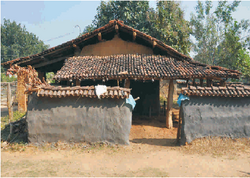Bagata people
Thank you for being part of the Bharatpedia family! 0% transparency: ₹0 raised out of ₹100,000 (0 supporter) |
Bhokta, Bhogata, Bhagata, Kapu | |
|---|---|
 A traditional house of Bagata people | |
| Regions with significant populations | |
| Andra Pradesh | 1,33,427 |
| Odisha | 8,813 |
| Telengana | 850 |
| Languages | |
| Telugu, Desia Odia, Regional languages | |
| Religion | |
| Hinduism, Christianity, Animism | |
Census 2011[1] | |
Bagata people are one of the tribal ethnic groups of India, mainly concentrated in Andhrapradesh and Odisha. As per the Indian constitution, they are designated as Scheduled Tribe for affirmative action.[2][3]
Population distribution[edit]
The Bagatas, are generally scattered in all districts of Odisha, Telengana, Andhrapradesh but are mainly concerned in Vishakapatnam, Vizianagaram, East Godavari, Rangareddy district of Andhra Pradesh (including Telengana);[4] Sundargarh, Mayurbhanj, Sambalpur, Baleshwar district of Odisha.[5]
Overview[edit]
Bagata is traditionally a Telugu ethnic fishermen tribe. They're alternatively written as Bhakta, Bhogata and Bhagata and in Andhrapradesh their local name is Kampu/ Kapu. In Andhrapradesh they use a dialect of the Telugu language, Desia Odia and in Odisha, they left Telugu and speak the regional language like Hindi, Odia, Sadri, Laria, and Kurmali. Bagata people bear biological traits of Proto-Australoid tribes of the south and center India.[3]
Social structure[edit]
The Bagatas are broadly divided into two divisions i.e. Vaishnavites and Saivites. The Vaishnavites found in Northern Odisha, are largely Hinduised with their belief in Vaishnavism. The Saivites are found in Northern Andhra Pradesh.[3]
The Bagata of Vaishnavas section is divided into totemic clans like Belhar (monkey), Samudia, Bamia, Tiruar (bird), Sarania (flute), Nag, Hatiar (elephant), Chumiar and Kuardar. They use their clan as a surname. However, some authors opined that there was no surname or subgroup system in them but after migration, they adopted those and now almost use surnames like other Hindu societies. Historically, they migrated to the Ranchi region of Chota Nagpur from Andhrapradesh before the 20th century and subsequently migrated to the northern district of Odisha.[3]
In 1976 the Bagata had the highest rate of indebtedness of any of the scheduled tribes of Andhra Pradesh.[6]
References[edit]
- ↑ "STATISTICAL PROFILE OF SCHEDULED TRIBES IN INDIA 2013" (PDF). www.tribal.nic.in. MINISTRY OF TRIBAL AFFAIRS STATISTICS DIVISION, Government of India. Archived (PDF) from the original on 12 July 2017. Retrieved 20 October 2021.
- ↑ "List of notified Scheduled Tribes" (PDF). Census India. pp. 13–14, 21–22. Archived from the original (PDF) on 7 November 2013. Retrieved 15 December 2013.
- ↑ 3.0 3.1 3.2 3.3 Ota, A.B. (2015). BAGATA. Scheduled Castes and Scheduled Tribes Research and Training Institute, BBSR. ISBN 978-93-80705-29-3.
- ↑ "A-11 Appendix: District wise scheduled tribe population (Appendix) - Andhrapradesh". censusindia.gov.in. Retrieved 27 June 2022.
- ↑ "A-11 Appendix: District wise scheduled tribe population (Appendix) - Odiaha". Retrieved 27 June 2022.
- ↑ "Welcome to aptribes.gov.in - A Portal of Tribal Welfare Department Govt of A.P". Aptribes.gov.in. Archived from the original on 29 May 2012. Retrieved 15 December 2013.
Further reading[edit]
- Thurston, Edgar. "Castes and Tribes of Southern India/Bagata - Wikisource, the free online library". en.wikisource.org. Retrieved 20 September 2021.
- "Bagata tribe" (PDF). tribal.nic.in.
{{cite web}}: CS1 maint: url-status (link)
- "Odisha State Tribal Museum | Bagata". Retrieved 20 September 2021.
- "Documenting the ethno-cultural practices of Bagata tribe of Andhra Pradesh | INTACH Intangible Cultural Heritage". Retrieved 27 October 2021.
- Naidu, J.M. "Ethnography of Bagatha Tribe in Andhra Pradesh" (PDF). Department of Tribal Welfare, Government of Andhra Pradesh. CENTRE FOR ECONOMIC AND SOCIAL STUDIES.
{{cite web}}: CS1 maint: url-status (link)
